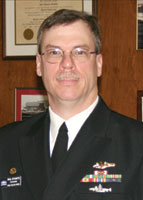2009 CEOs Who 'Get It'
 Captain Neil C. Stubits
Captain Neil C. Stubits
Commander
Indian Head Division,
Naval Surface Warfare Center
Indian Head Division, Naval Surface Warfare Center supports the warfighter through the research, development, manufacturing and testing of ordnance and weapons systems components. Located in Indian Head, MD, the center consists of 1,352 employees, of which 1,254 are civilians, 6 are military and 92 are contractors.
Why is safety a core value at your center?
Safety is a core value at my command because it serves as the bedrock for everything we do. We deal with explosives, propellants and rocket motors, commonly referred to as energetic materials. Our products support the warfighter. In that capacity, any unsafe act, mishap or worse has the potential to adversely impact the individuals involved in the task or the command as a whole, and can disrupt the flow of products and services to our military men and women in the field.
How do you instill a sense of safety in your employees on an ongoing basis?
I think there are three fundamental keys to instilling safety in your employees: presence, accountability and empowerment. I believe in “management by walking around.” As a supervisor, you need to be seen in the workplace promoting safety; more importantly, you need to be seen when things are going right as much as when things are going wrong. If you walk by a safety violation and don’t bring it to someone’s attention, you have just indicated to your workers what you are willing to accept. The level of accountability varies with the severity of the violation, but recognition and accountability are key. Empowerment is giving your employees the ability to change unsafe things in their work environments, stop the production line if need be, and get their supervisors involved. Obviously, many supervisors don’t like empowering their employees because they feel they have given up control when, in most cases, they have given the power to the individuals who have the most knowledge and ability to safely make the necessary changes. Empowerment is the basis for ownership, and instilling a sense of safety is all about ownership of the workplace and the process.
What is the biggest obstacle to safety in your workplace, and how do you work to overcome it?
Culture is the biggest obstacle. A large percentage of the workforce believes safety is the responsibility of the safety department. The rules, regulations and guidance generate from that department and represent a minimum standard of compliance. This view has built up over time. Changing the mindset of workplace employees is a difficult task, but necessary if an organization is to go beyond compliance.
How does safety “pay” at your company?
My command operates like a business. We have customers who pay for products and services. If an unsafe act, violation or mishap halts the production line, delays our support or – more importantly – injures an employee, the command loses revenue. If a worker’s injury results in a long-term separation from the worksite, then we have potentially lost another valuable resource: intellectual capital, which also can impact our revenue stream. More importantly, an unsafe act, violation or mishap can impact our ability to support the warfighter.
How do you measure safety? What are the leading indicators that show you how safe you are, and where do you see room for improvement?
Safety is calculated not only by viewing reports and scrutinizing vast amounts of data, but also it is measured in the very hearts of the workers here at our command. If employees do not feel they have the tools, equipment and environment to keep them safe, they will not be able to work proficiently. At the senior leadership level, we conduct reviews of mishap statistics and data, as well as a review of supervisor and safety injury/illness investigative reports, and use them to understand systematic problem areas and determine corporate goals. As a result, we exceeded 400 days without a reportable mishap and almost 330 days without a lost-workday injury.
Post a comment to this article
Safety+Health welcomes comments that promote respectful dialogue. Please stay on topic. Comments that contain personal attacks, profanity or abusive language – or those aggressively promoting products or services – will be removed. We reserve the right to determine which comments violate our comment policy. (Anonymous comments are welcome; merely skip the “name” field in the comment box. An email address is required but will not be included with your comment.)

